

How Technology Can Benefit Physical Education Classes - The Tech Edvocate. 5 Simple Ways to Improve Physical Education w/ #Edtech. Today Jarrod Robinson @mrrobbo gives us the apps, tools, and mindset to rock physical education class.
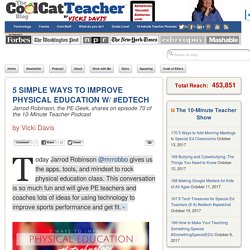
This conversation is so much fun and will give PE teachers and coaches lots of ideas for using technology to improve sports performance and get fit.1 Listen Now Listen on iTunes Click the button for iTunes or Stitcher to subscribe to this show In today’s show, Jarod Robinson geeks out Physical Education Class: Replay apps to help kids see what to improveTeam creation apps to make picking teams fasterCustom Workouts with SworkitFast fitness music on fit radioMaking fitness portfolios with Seesaw I hope you enjoy this episode with Jarod Robinson!
Selected Links from this Episode Scroll down to read the transcript for how he uses these apps or listen now. Full Bio As Submitted Jarrod Robinson I travel the world helping #physed teachers use technology more meaningfully in their classes. Teaching Philosophy. Health & Physical Education. Exercise: An Antidote for Behavioral Issues in Students? MONDAY, Jan. 9, 2017 (HealthDay News) -- Children with serious behavioral disorders might fare better at school if they get some exercise during the day, a new study suggests.
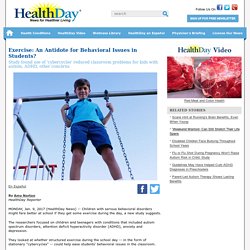
The researchers focused on children and teenagers with conditions that included autism spectrum disorders, attention deficit hyperactivity disorder (ADHD), anxiety and depression. They looked at whether structured exercise during the school day -- in the form of stationary "cybercycles" -- could help ease students' behavioral issues in the classroom. Over a period of seven weeks, the study found it did. Kids were about one-third to 50 percent less likely to act out in class, compared to a seven-week period when they took standard gym classes. Those effects are meaningful, according to lead researcher April Bowling, who was a doctoral student at Harvard University at the time of the study. PE 'Cinderella subject' for too long, says report.
Image copyright Thinkstock The status of physical education in schools needs a "radical shake-up" and it should be valued in the same way as core academics subjects, a report says.

A study by the All-Party Parliamentary Group (APPG) on a Fit and Healthy Childhood says PE has for too long been the "Cinderella subject" in UK schools. The group recommends a personalised PE programme for each individual child.
Physical Education. The Health and Physical Education Web site for Teachers/PE Central. Understanding Inquiry in Health and Physical Education. What is Inquiry-Based Learning “Inquiry-based learning is a process where students are involved in their learning, formulating questions, investigate widely and then build new understandings, meanings and knowledge.
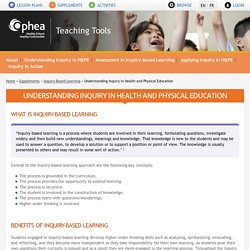
That knowledge is new to the students and may be used to answer a question, to develop a solution or to support a position or point of view. The knowledge is usually presented to others and may result in some sort of action. " 1 Central to the Inquiry-based learning approach are the following key concepts: The process is grounded in the curriculum.The process provides the opportunity to extend learning.The process is recursive.The student is involved in the construction of knowledge.The process starts with questions/wonderings.Higher-order thinking is involved.
Strategies for Asking Questions. 2016 Shape of the Nation: At the Heart of Physical Education is Kids’ Health. Dallas, Texas –Students across the nation would benefit from strong state requirements for physical education.
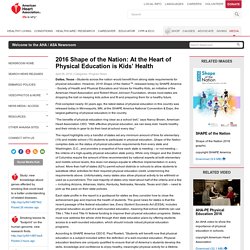
However, 2016 Shape of the Nation™, released today by SHAPE America - Society of Health and Physical Educators and Voices for Healthy Kids, an initiative of the American Heart Association and Robert Wood Johnson Foundation, shows most states are dropping the ball on keeping kids active and fit and preparing them for a healthy future. First compiled nearly 30 years ago, the latest status of physical education in this country was released today in Minneapolis, MN, at the SHAPE America National Convention & Expo, the largest gathering of physical educators in the country. “The benefits of physical education ring clear as a school bell,” says Nancy Brown, American Heart Association CEO. “With effective physical education, we can keep kids’ hearts healthy and their minds in gear to do their best at school every day.” According to SHAPE America CEO E. Additional Resources: Health and Physical Education Subject Guide. Canada releases world’s first 24-hour movement behaviour guidelines : SBRN.
On June 26 Canada released the Canadian 24 Hour Movement Guidelines for Children and Youth.
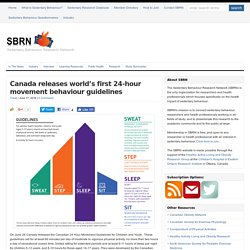
These guidelines call for at least 60 minutes per day of moderate to vigorous physical activity, no more than two hours a day of recreational screen time, limited sitting for extended periods and at least 9-11 hours of sleep per night for children 5-13 years, and 8-10 hours for those aged 14-17 years. They were developed by the Canadian Society for Exercise Physiology, the Conference Board of Canada, HALO-CHEO, ParticipACTION and the Public Health Agency of Canada, with input from research experts and stakeholders across Canada and around the world. The process was informed by 9 peer-reviewed publications, all available for free via the journal of Applied Physiology, Nutrition and Metabolism. Three papers of particular relevance to sedentary behaviour: